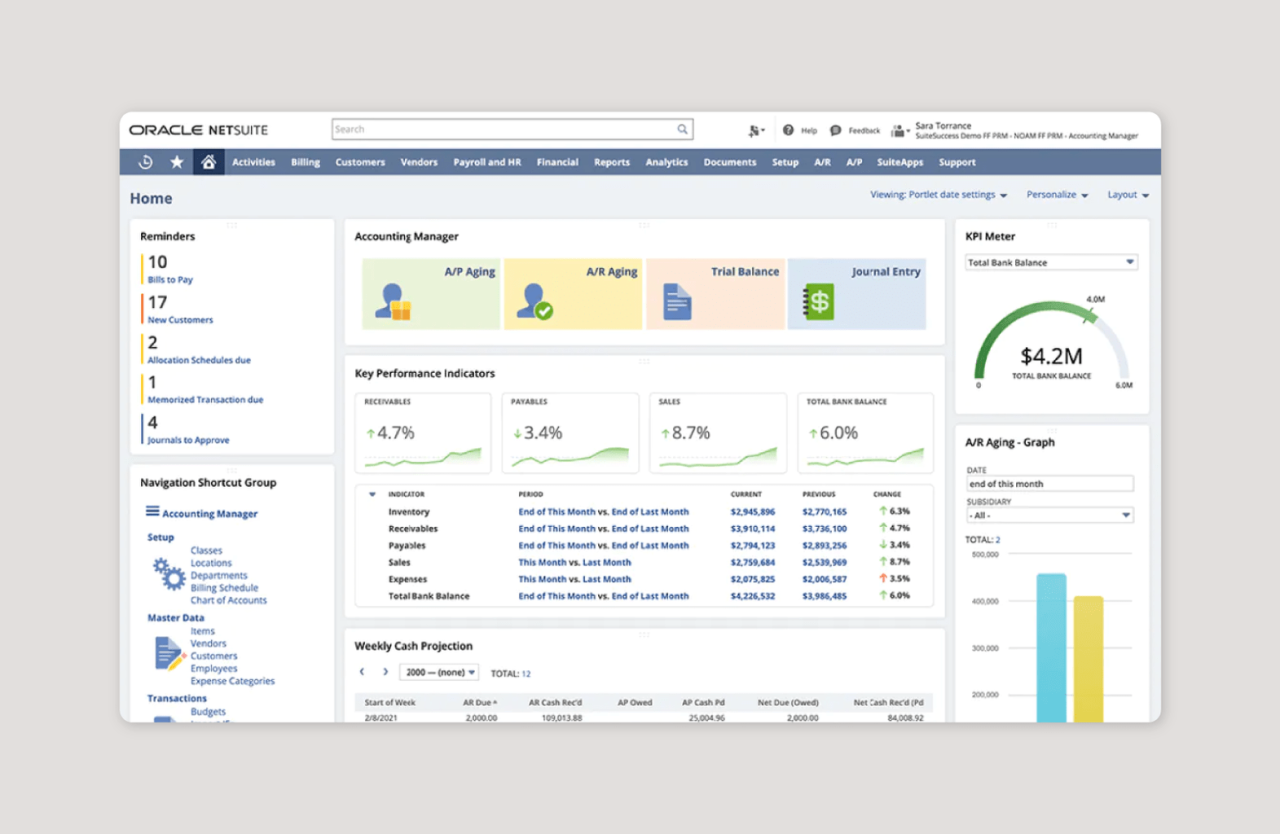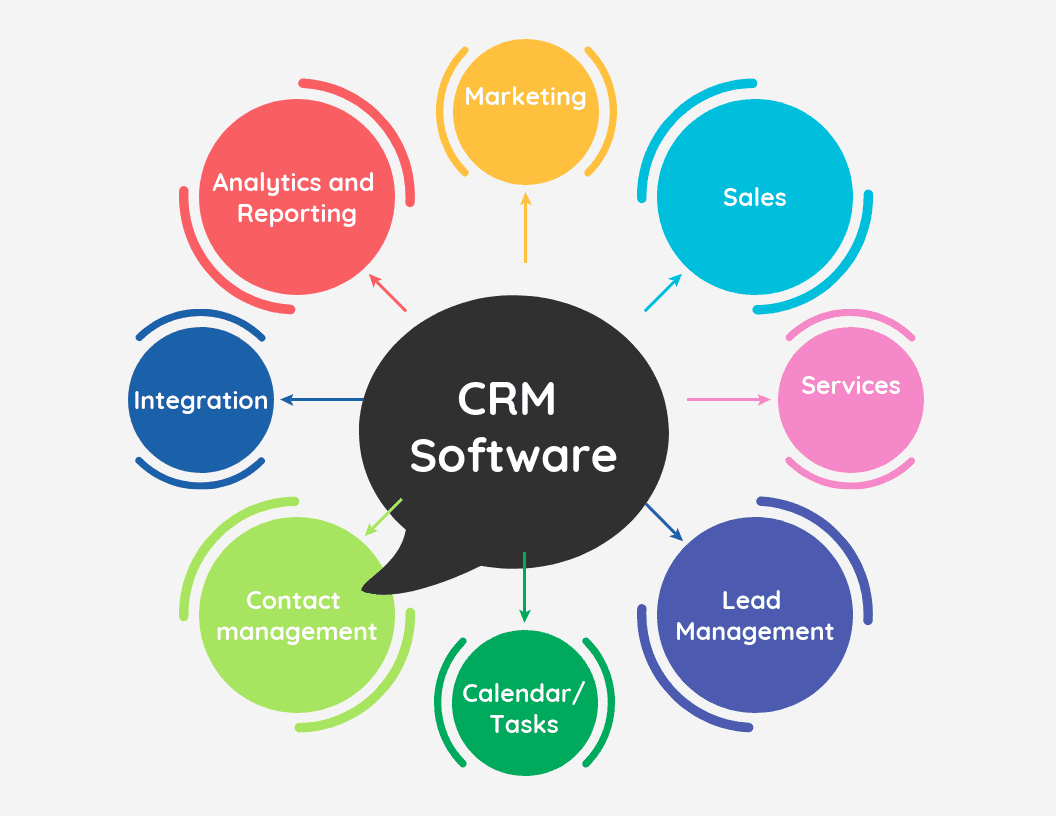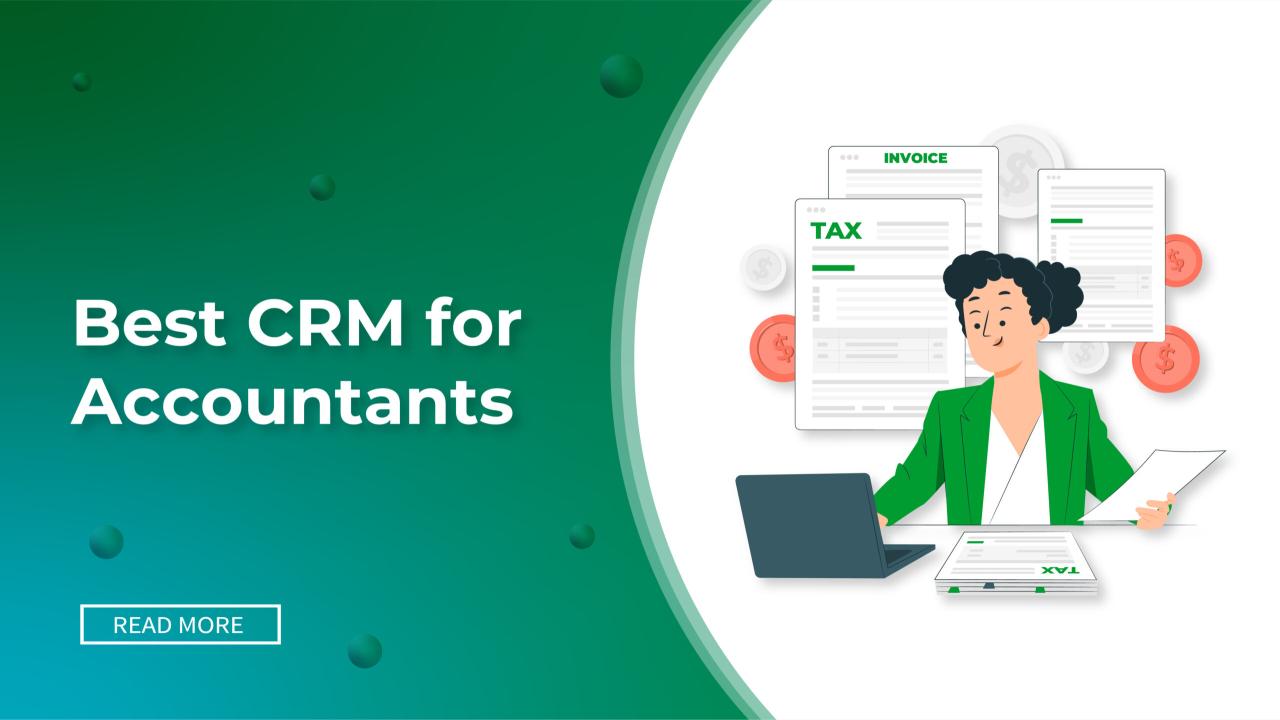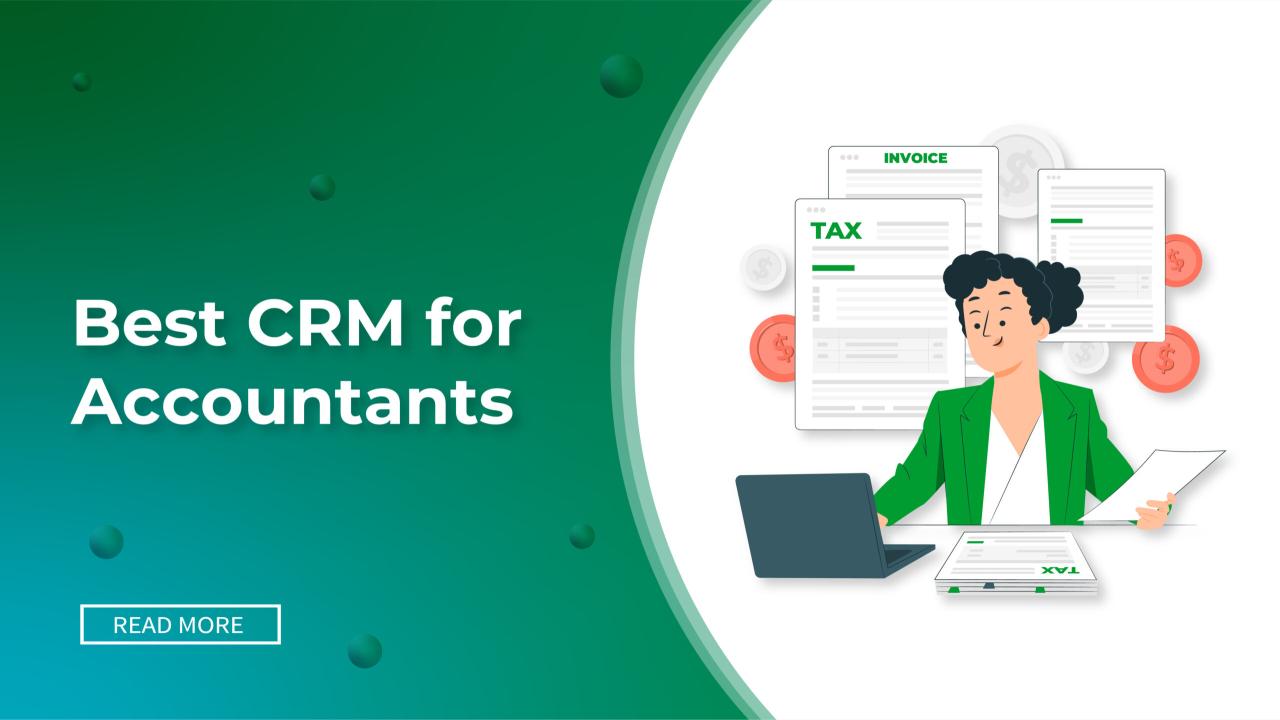Best CRM and accounting software solutions are crucial for businesses of all sizes, streamlining operations and improving financial management. Finding the right integration depends heavily on specific needs, from simple invoicing for freelancers to complex inventory management for enterprises. This guide explores key factors to consider when selecting a system, comparing popular options, and analyzing the impact on efficiency and ROI.
We’ll delve into the criteria for defining “best,” examining scalability, user-friendliness, cost-effectiveness, and seamless integration capabilities. Different user profiles—small businesses, enterprises, and freelancers—have unique requirements, and we’ll explore how to match software to these varying needs. Understanding the key features that distinguish top-tier solutions from basic options is critical for making an informed decision.
Defining “Best” CRM and Accounting Software
Choosing the “best” CRM and accounting software isn’t a simple task; it heavily depends on individual business needs and priorities. There’s no one-size-fits-all solution. Instead, the ideal software emerges from a careful evaluation of several key factors, balancing functionality with cost-effectiveness and ease of use.Defining “best” requires a multi-faceted approach. Crucial considerations include the software’s scalability to accommodate growth, its user-friendliness for both technical and non-technical staff, the overall cost of ownership (including implementation, training, and ongoing maintenance), and most importantly, its seamless integration capabilities between the CRM and accounting modules.
A strong integration prevents data silos and ensures efficient workflows. Poor integration can lead to significant time wasted on manual data entry and reconciliation.
Criteria for Evaluating CRM and Accounting Software
Several key factors determine whether a particular software package is a good fit. Scalability ensures the software can adapt to a company’s growth without requiring a complete system overhaul. User-friendliness directly impacts productivity and employee satisfaction. Cost includes not just the initial license fee but also ongoing subscription costs, support fees, and the potential costs associated with customization or integration with other systems.
Finally, robust integration between CRM and accounting functions is critical for accurate financial reporting and efficient business management. A system that lacks smooth integration between these crucial functions will likely cause more problems than it solves.
User Profiles and Specific Needs
Different user profiles have vastly different requirements. A small business, for example, might prioritize affordability and ease of use, focusing on basic features like contact management, invoicing, and expense tracking. An enterprise, however, will need a more robust and scalable solution capable of handling complex workflows, managing large datasets, and integrating with numerous other enterprise systems. A freelancer might require a simpler system with strong invoicing and payment processing capabilities, but might not need advanced features for managing sales teams or complex inventory.
- Small Business (e.g., a bakery): Needs a user-friendly system with integrated invoicing, expense tracking, and basic contact management. Scalability is less critical initially, but ease of use and affordability are paramount.
- Enterprise (e.g., a multinational corporation): Requires a highly scalable and customizable system with advanced features such as sales force automation, marketing automation, comprehensive reporting, and robust security measures. Integration with existing enterprise resource planning (ERP) systems is crucial.
- Freelancer (e.g., a graphic designer): Needs a simple system with strong invoicing and payment processing capabilities, time tracking, and project management tools. The system should be easy to use and manage, with minimal administrative overhead.
Key Features Differentiating Top-Tier and Basic Solutions
Top-tier CRM and accounting software packages stand out through their advanced features and capabilities. These features often include advanced reporting and analytics dashboards, allowing businesses to gain deeper insights into their performance. They typically offer robust automation capabilities, streamlining repetitive tasks and freeing up valuable time. Furthermore, superior integration with other business tools and APIs enhances overall efficiency and data management.
Basic options, on the other hand, often lack these sophisticated features and may have limitations in terms of scalability and customization.
A top-tier solution will seamlessly integrate CRM data (customer interactions, sales opportunities) with accounting data (invoices, payments, expenses), providing a holistic view of the business’s financial health and customer relationships.
Popular CRM and Accounting Software Integrations

Integrating CRM and accounting software streamlines business operations by creating a unified view of customer interactions and financial data. This integration eliminates manual data entry, reduces errors, and provides valuable insights for improved decision-making. Effective integration allows for a seamless flow of information between sales, marketing, and finance departments, fostering better collaboration and efficiency.
CRM and Accounting Software Integration Comparison
The choice of CRM and accounting software integration depends heavily on a business’s specific needs and size. Below is a comparison of three popular CRM platforms integrated with three leading accounting software solutions. Note that features and pricing can change, so always check the latest information on the vendor’s website.
| Software Name | Key Features | Integration Strengths | Pricing Model |
|---|---|---|---|
| Salesforce + QuickBooks Online | Salesforce: Sales force automation, marketing automation, customer service; QuickBooks Online: invoicing, expense tracking, financial reporting | Robust integration via app exchange, real-time data synchronization, automated invoice creation from sales opportunities. | Salesforce: Subscription based, tiered pricing; QuickBooks Online: Subscription based, tiered pricing. |
| HubSpot + Xero | HubSpot: CRM, marketing automation, sales automation, service hub; Xero: invoicing, accounting, payroll, reporting | Seamless integration via native app, streamlined data flow between marketing and finance, improved customer relationship management. | HubSpot: Freemium model, tiered subscription pricing; Xero: Subscription based, tiered pricing. |
| Zoho CRM + FreshBooks | Zoho CRM: Sales force automation, contact management, marketing automation; FreshBooks: invoicing, time tracking, expense management | Strong integration capabilities, automated invoice generation, efficient data management. | Zoho CRM: Subscription based, tiered pricing; FreshBooks: Subscription based, tiered pricing. |
Pre-built vs. Custom Integrations, Best crm and accounting software
The decision between pre-built and custom integrations hinges on factors like budget, technical expertise, and specific business requirements.Pre-built integrations offer a cost-effective and readily available solution, often requiring minimal technical expertise to implement. However, they may lack the flexibility to address highly specific business needs. Customization may be limited to configuring existing functionalities.Custom integrations, while more expensive and requiring significant technical resources, provide unparalleled flexibility and can be tailored to meet unique business requirements.
This approach allows for the creation of seamless workflows not possible with pre-built solutions. However, it necessitates ongoing maintenance and updates.
Examples of Successful CRM and Accounting Software Integrations Across Industries
Successful integrations are seen across various industries. For example, a SaaS company might use Salesforce and QuickBooks Online to track sales leads, manage customer accounts, and generate invoices automatically. This integration provides real-time visibility into sales performance and financial health. Similarly, a marketing agency might leverage HubSpot and Xero to manage client projects, track expenses, and invoice clients efficiently, enhancing project profitability tracking.
Finally, a small business owner might utilize Zoho CRM and FreshBooks for simple sales management and invoicing, streamlining administrative tasks and improving cash flow.
Data Management and Security Considerations: Best Crm And Accounting Software

Choosing the right CRM and accounting software involves careful consideration of how your sensitive data will be managed and protected. Leading providers understand this critical aspect and implement robust security measures to safeguard financial and customer information. This section explores the data management and security protocols employed by these providers, along with disaster recovery and breach response strategies.Data security is paramount for any business using CRM and accounting software.
Breaches can lead to significant financial losses, reputational damage, and legal repercussions. Therefore, understanding the security features offered by your chosen software is essential.
Security Protocols Employed by Leading Providers
Leading CRM and accounting software providers typically employ a multi-layered security approach. This includes measures like data encryption both in transit (using protocols like HTTPS) and at rest (using encryption algorithms like AES-256). They also implement access controls, using role-based permissions to restrict access to sensitive data based on employee roles and responsibilities. Regular security audits and penetration testing are common practices to identify and address vulnerabilities proactively.
Multi-factor authentication (MFA) is often mandatory, adding an extra layer of security to user logins. Furthermore, many providers leverage intrusion detection and prevention systems to monitor for and block malicious activity. Compliance with industry standards such as SOC 2, ISO 27001, and GDPR is also a key indicator of a provider’s commitment to data security.
Data Backup, Recovery, and Disaster Preparedness
Robust data backup and recovery mechanisms are crucial for business continuity. Leading providers typically offer automated, offsite backups, ensuring data redundancy and protection against data loss due to hardware failure, natural disasters, or cyberattacks. These backups are often stored in geographically diverse locations to further mitigate risk. Disaster recovery plans are also in place, outlining procedures for restoring data and systems in the event of a major outage or disaster.
Regular testing of these recovery plans ensures their effectiveness and helps identify any weaknesses. The frequency of backups and the recovery time objective (RTO) and recovery point objective (RPO) are key metrics to consider when evaluating a provider’s disaster preparedness capabilities. For example, a provider might offer daily backups with an RTO of 4 hours and an RPO of 24 hours.
Hypothetical Data Breach Scenario and Mitigation
Let’s consider a scenario where a phishing attack successfully compromises the credentials of a finance employee. The attacker gains access to the accounting software and attempts to transfer funds to an external account. The mitigation steps would involve:
- Immediate Detection: Intrusion detection systems and user activity monitoring would ideally flag suspicious login attempts and unauthorized transactions.
- Containment: The compromised account would be immediately locked, preventing further access. Network segmentation would help limit the attacker’s lateral movement within the system.
- Investigation: A thorough forensic investigation would determine the extent of the breach, identifying compromised data and the attacker’s methods.
- Notification: Affected parties, including customers and regulatory bodies (where applicable), would be notified in accordance with relevant regulations and best practices.
- Remediation: Vulnerabilities exploited in the attack would be patched, and security protocols would be strengthened to prevent future incidents. This might include implementing additional MFA, enhancing phishing awareness training for employees, and reviewing access control policies.
- Recovery: Data would be restored from backups, and business operations would be resumed. A post-incident review would analyze the event to identify lessons learned and improve future security measures.
Workflow Automation and Efficiency

Integrating CRM and accounting software offers substantial benefits by automating previously manual and time-consuming business processes. This integration streamlines operations, reduces errors, and frees up valuable employee time for more strategic tasks. The resulting efficiency translates directly to improved profitability and a more positive customer experience.The seamless flow of data between CRM and accounting systems allows for a more holistic view of the business, improving decision-making across departments.
This section will explore how automation enhances key business processes.
Improved Sales Cycle Management
Automating the sales cycle significantly reduces manual effort and accelerates the process from lead generation to invoice payment. The integration of CRM and accounting software enables a smooth transition between stages, minimizing delays and improving conversion rates.
- Lead Qualification and Assignment: Incoming leads are automatically categorized and routed to the appropriate sales representative based on pre-defined criteria (e.g., industry, location, purchase history). This ensures timely follow-up and maximizes conversion potential.
- Automated Email Sequences: Pre-written email sequences are triggered based on customer actions or milestones in the sales process. This ensures consistent communication and nurtures leads effectively, without manual intervention.
- Proposal and Contract Generation: Once a deal is closed, the system automatically generates proposals and contracts based on the agreed-upon terms. This minimizes errors and accelerates the contracting process.
- Invoice Creation and Tracking: Upon contract signing, the system automatically generates invoices, records payments, and tracks outstanding balances, providing real-time visibility into sales revenue.
Streamlined Order Fulfillment and Inventory Management
Connecting CRM and accounting systems optimizes order fulfillment by automating inventory tracking, reducing stockouts, and improving order accuracy. This leads to improved customer satisfaction and reduced operational costs.
- Automated Order Processing: When a customer places an order through the CRM, the system automatically updates inventory levels in the accounting software, preventing overselling and ensuring timely fulfillment.
- Real-time Inventory Monitoring: The integrated system provides real-time visibility into inventory levels, allowing businesses to proactively manage stock and prevent shortages. Low-stock alerts can trigger automatic reordering processes.
- Automated Shipping Notifications: Once an order is shipped, the system automatically sends shipping notifications to customers, improving transparency and reducing customer inquiries.
- Automated Purchase Order Generation: When inventory levels fall below a pre-defined threshold, the system automatically generates purchase orders to replenish stock, streamlining the procurement process.
Enhanced Customer Support and Issue Resolution
Integrating CRM and accounting systems improves customer service by providing a complete view of customer interactions and financial history. This enables more efficient issue resolution and proactive customer support.
- Centralized Customer Data: All customer interactions (emails, calls, support tickets) and financial transactions are stored in a centralized location, providing a 360-degree view of each customer.
- Automated Support Ticket Routing: Support tickets are automatically routed to the appropriate support agent based on customer history, issue type, and agent expertise.
- Automated Refund Processing: The system can automate the refund process for returned goods or services, reducing manual effort and improving customer satisfaction.
- Automated Customer Satisfaction Surveys: Following a service interaction, the system can automatically send customer satisfaction surveys, providing valuable feedback for service improvement.
Typical Workflow: CRM and Accounting Integration
A flowchart illustrating the typical workflow would show a cyclical process starting with Lead Generation (CRM), moving to Sales (CRM & Accounting data exchange for proposals/contracts), Order Fulfillment (Accounting updates inventory, CRM updates customer status), Customer Support (CRM tracks interactions, Accounting manages refunds/credits), and finally, Reporting & Analysis (both systems contribute data for financial performance and customer insights). The arrows connecting each stage represent the automated data flow between the CRM and accounting systems.
The entire cycle demonstrates how integrated systems facilitate efficient and informed business decisions.
Cost Analysis and Return on Investment (ROI)
Choosing the right CRM and accounting software involves a careful consideration of costs and the potential return on that investment. Understanding the total cost of ownership (TCO) and developing a robust ROI calculation are crucial for justifying the expense and ensuring a successful implementation. This section will explore these aspects, providing a framework for making informed decisions.
Total Cost of Ownership (TCO) Comparison
The total cost of ownership encompasses more than just the initial licensing fee. It includes implementation costs, such as training, data migration, and customization, as well as ongoing maintenance, support, and potential upgrades. The following table compares the TCO for three popular software packages – these are illustrative examples and actual costs will vary based on specific needs and vendor pricing.
| Software | Licensing Cost (Annual) | Implementation Cost (One-time) | Ongoing Maintenance (Annual) |
|---|---|---|---|
| Software A (e.g., Salesforce Sales Cloud) | $10,000 – $50,000+ (depending on user count and features) | $5,000 – $20,000 (depending on data migration complexity and customization) | $2,000 – $10,000 (depending on support level and add-ons) |
| Software B (e.g., Xero) | $30 – $1000+ (depending on user count and features) | $500 – $5,000 (depending on complexity and integration needs) | $100 – $500 (depending on support level and add-ons) |
| Software C (e.g., Zoho CRM and Zoho Books) | $10 – $1000+ (depending on user count and features) | $100 – $2000 (depending on complexity and integration needs) | $50 – $500 (depending on support level and add-ons) |
Calculating ROI for Integrated CRM and Accounting Software
Calculating the ROI involves comparing the net benefits of the software against its total cost. The formula is:
ROI = (Net Benefits – Total Cost) / Total Cost
Net benefits can include increased sales, reduced operational costs, improved efficiency, and minimized errors. These need to be quantified to provide a meaningful ROI calculation. For example, if the software leads to a 10% increase in sales and a 5% reduction in operational costs, these figures need to be translated into dollar amounts.
Tangible Financial Benefits of Improved Efficiency and Reduced Errors
Improved efficiency translates to reduced labor costs. For example, automating invoice processing can save hours of manual work per week, leading to significant cost savings over time. Similarly, reduced errors in data entry and reporting minimize costly rework, lost revenue due to inaccurate invoices, and penalties for late filings. A reduction in customer service calls due to improved order tracking and information accessibility further contributes to cost savings.
A hypothetical example: If manual invoice processing costs $50 per invoice and automation reduces errors by 10% on 1000 invoices annually, this represents a savings of $5000. A 5% reduction in customer service calls, assuming each call costs $10 and the company receives 5000 calls per year, would represent an additional savings of $2500. These savings contribute directly to a positive ROI.
User Experience and Training
Choosing the right CRM and accounting software hinges not only on features and functionality but also on how easily users can adopt and utilize the system. A user-friendly interface and effective training are crucial for maximizing the software’s potential and ensuring a positive return on investment. Poor user experience can lead to low adoption rates, decreased productivity, and ultimately, wasted resources.The importance of intuitive design and comprehensive training cannot be overstated.
Software that is difficult to navigate or understand will frustrate users, leading to resistance and potentially hindering the achievement of business goals. Conversely, a well-designed system, coupled with adequate training, empowers users to work efficiently and effectively, improving overall business performance.
Intuitive Navigation and User-Friendly Interfaces
A positive user experience begins with an intuitive interface. This means a clean, uncluttered design with clear visual cues, logical workflows, and easy-to-understand terminology. Effective navigation should allow users to quickly find the information and tools they need without extensive searching or training. Consider software like Xero, known for its clean interface and straightforward navigation, as an example of a positive user experience.
Its dashboard provides a clear overview of key financial information, and its menu system is logically organized, making it easy for users to find the features they need. In contrast, a poorly designed interface might present users with cluttered screens, confusing menus, and inconsistent terminology, leading to frustration and decreased productivity.
Training Resources Offered by Software Providers
Software providers typically offer a range of training resources to facilitate user adoption. These often include online tutorials, video demonstrations, user manuals, and even live webinars or in-person training sessions. Some providers offer personalized onboarding services, guiding new users through the initial setup and configuration of the software. The availability and quality of these resources vary significantly between providers.
For instance, Salesforce, a leading CRM provider, offers extensive online training resources, including detailed documentation, video tutorials, and online courses, catering to users of all skill levels. This comprehensive approach to training significantly improves user adoption and proficiency.
Key Features Contributing to a Positive User Experience
Several key features contribute significantly to a positive user experience in CRM and accounting software. These features often work synergistically to create a seamless and efficient workflow.
- Customizable Dashboards: Allow users to personalize their views, focusing on the metrics and information most relevant to their roles.
- Intuitive Search Functionality: Enables quick and easy retrieval of information, saving time and effort.
- Robust Reporting and Analytics Capabilities: Provide clear and concise insights into business performance, facilitating informed decision-making.
- Mobile Accessibility: Enables users to access and manage data from anywhere, anytime, enhancing flexibility and productivity.
- Excellent Customer Support: Provides readily available assistance when users encounter issues or require guidance.
- Integration with Other Business Tools: Streamlines workflows by connecting the CRM and accounting software with other essential applications.
Future Trends in Integrated CRM and Accounting Software

The convergence of CRM and accounting software is accelerating, driven by advancements in technology and evolving business needs. The future of these integrated systems promises greater efficiency, deeper insights, and more streamlined workflows, all powered by increasingly sophisticated technologies. This section explores the key trends shaping the future landscape of integrated CRM and accounting software.
Emerging technologies are rapidly transforming how businesses manage their relationships and finances. Artificial intelligence (AI) and machine learning (ML) are at the forefront of this transformation, promising to automate tasks, improve accuracy, and unlock valuable insights from data previously inaccessible.
The Impact of AI and Machine Learning
AI and ML are poised to revolutionize integrated CRM and accounting software in several ways. AI-powered chatbots can handle routine customer inquiries, freeing up human agents to focus on more complex issues. ML algorithms can analyze sales data to predict future trends and optimize pricing strategies. Furthermore, these technologies can automate invoice processing, reconcile accounts, and detect potential fraud, significantly reducing manual effort and the risk of errors.
For example, Xero, a popular accounting software, already utilizes ML for features like automated bank reconciliation and expense categorization. Similarly, Salesforce, a leading CRM provider, uses AI to personalize customer interactions and predict customer churn.
Evolution of Integration Capabilities and User Interfaces
We can expect increasingly seamless integration between CRM and accounting systems. Real-time data synchronization will become the norm, eliminating the need for manual data entry and reducing the risk of inconsistencies. User interfaces will become more intuitive and user-friendly, with features like drag-and-drop functionality and customizable dashboards. Imagine a scenario where a sales representative closes a deal in the CRM, and the corresponding invoice is automatically generated and sent to the client within the integrated accounting system, all without manual intervention.
This level of automation is already emerging in some advanced systems and will become increasingly commonplace.
Challenges and Opportunities Presented by Emerging Trends
While the future of integrated CRM and accounting software is bright, several challenges must be addressed. Data security and privacy are paramount concerns, particularly as more sensitive financial and customer data is stored and processed. Ensuring compliance with relevant regulations, such as GDPR and CCPA, will be crucial. The cost of implementing and maintaining AI-powered systems can also be a barrier for smaller businesses.
However, the opportunities outweigh the challenges. Improved efficiency, enhanced decision-making, and increased profitability are just some of the potential benefits of embracing these emerging technologies. The companies that successfully navigate these challenges will be well-positioned to gain a competitive advantage in the marketplace.
Last Recap
Ultimately, selecting the best CRM and accounting software involves careful consideration of your specific business needs, budget, and long-term goals. By understanding the factors Artikeld in this guide—from integration capabilities and security protocols to user experience and ROI—businesses can make informed decisions that optimize their operations and contribute to sustainable growth. The right software can transform how you manage finances and customer relationships, paving the way for increased efficiency and profitability.
Essential Questionnaire
What is the difference between cloud-based and on-premise CRM and accounting software?
Cloud-based software is hosted on the provider’s servers, accessible via the internet. On-premise software is installed and maintained on your own servers. Cloud solutions offer greater accessibility and scalability, while on-premise provides more control over data security but requires significant IT infrastructure.
How can I ensure data security with integrated CRM and accounting software?
Choose reputable providers with robust security protocols, including encryption, access controls, and regular security audits. Implement strong password policies and two-factor authentication. Regularly back up your data and establish a disaster recovery plan.
What is the typical implementation timeline for integrated CRM and accounting software?
Implementation timelines vary greatly depending on the complexity of the software and the size of your business. Smaller businesses might see implementation within weeks, while larger enterprises could take months.
What are some common integration challenges?
Data migration issues, compatibility problems between different systems, and the need for custom development are common integration challenges. Thorough planning and selecting a provider with strong integration capabilities can mitigate these risks.

